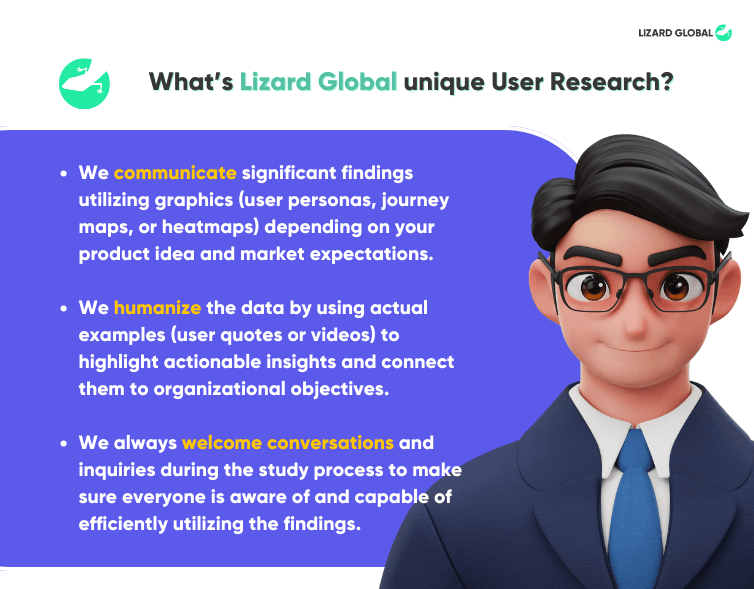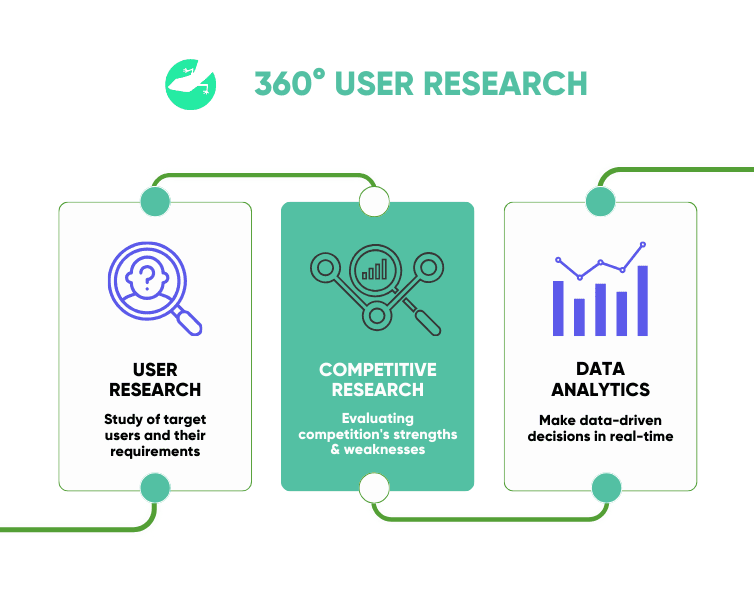What Is User Research in UI/UX? What Are the Benefits?
Get the latest updates about our blog posts.
Subscribe so you don’t miss out!
Follow Lizard Global on Facebook, Instagram, and LinkedIn.
The cornerstone of successful UX is user research, but what are the benefits specifically? By taking this important step, you can be sure that you're creating the features and goods that will best suit your target audience and that you're addressing the issues that they genuinely need you to address.
User research is crucial, as a UX designer you are aware of this. However, how can you explain the benefits it offers to the organization as a whole as well as your creative process?
In this article, we'll explain what user research is, how it's done, how it fits into the design process, and how important it actually is. Learn more about the advantages of user research in UI/UX by reading on.
What is User Research in UX?
User research is the methodical examination of target users and their needs with the goal of providing design processes with relevant contexts and insights.
User research is an essential component of the overall Product Design process in UX design. It allows Designers to get to know the intended audience, enabling them to clearly understand who they're designing to cater to and why, the issues their customers face in connection with the product or service, the needs and wants of your buyers for the product, service, or feature you're designing, and ultimately ensuring that you're designing to satisfy the needs of the end user.
UX researchers use a variety of techniques to identify issues and design opportunities. By doing this, they make important discoveries that can be used to inform the design process.
We discovered as a full-stack digital partner that a focused and organized approach is effective. Our Product Designers at Lizard Global always begin with a specific objective to establish expectations. With this strategy, stakeholders' access to the benefits of user research is maximized.

- We communicate significant findings utilizing graphics like user personas, journey maps, or heatmaps depending on your product idea and market expectations.
- We humanize the data by using actual examples, such as user quotes or videos, to highlight actionable insights and connect them to organizational objectives.
- We always welcome conversations and inquiries from those working with us during the study process to make sure everyone is aware of and capable of efficiently utilizing the findings.
How to conduct successful User Research in UX?
User research is an ongoing process. UX designers (or specialist UX researchers) acquire information about their target users using one or more user research techniques during the user research phase.
When doing usability study research, the following steps are often followed:
- Outlining the aims and objectives of the research.
- Seeking volunteers who belong to the intended user base.
- Making an organized and thorough task list.
- Making use of a standard procedure for gathering data.
- Analyze your data and synthesize results (Affinity maps, heuristic charts, user journey maps, user personas, and more).
- Come up with the next steps and recommendations on how to move forward.
The precise techniques employed will depend on when the research is being undertaken (for example, to learn more about the users of a current product or before building a brand-new one), the types of insights you want to locate, as well as the amount of time and money available. To convert your user research findings into ideas that can be put into practice, it's crucial to analyze and synthesize your findings.
The different types of User Research
User research can be either qualitative or quantitative in nature. There are many different user research techniques available for learning about people and their needs.
1. Qualitative User Research
Qualitative user research investigates the thoughts and emotions of the target audience surrounding their interactions with a specific brand, item, or service. It covers techniques including ethnographic research, user interviews, and surveys with open-ended questions that encourage qualitative responses (rather than merely a yes/no or number rating).
Interviews are a type of qualitative research methodology where consumers are spoken to in person or over the phone to gain insight into their beliefs, actions, and experiences. Interviews can be unstructured, with the interviewer's observations driving the conversation, or planned, with a pre-prepared list of questions.
What is Ethnographic research? It is a kind of study that looks at people's behaviors and habits by watching and interacting with them in their homes or places of employment.
2. Quantitative User Research
Quantitative user research provides quantifiable, or quantitative, data. It yields objective insights, like the number of occurrences a user clicks on a specific button in a given amount of time or the typical time it takes the user to do a job.
Surveys are a type of quantitative research methodology where a structured questionnaire is used to gather responses from an array of participants. You can conduct surveys in person, over video calls, or online to get feedback on a product or service as well as demographic data.
Do you know you can combine quantitative and qualitative User Research in one go? That’s how Lizard Global do our surveys! Faster, better, and time-efficient! Combining Competitive Research allows our Product Designers to to identify the opportunities in the market and have a validation of research from two angles or more.


6 benefits of User Research in UX
When you design without conducting UX research, you are essentially making assumptions. Without interacting with actual users, it is practically hard to determine what wants and pain issues your design should address. For the following reasons, user research is vitally important:
1. Evaluate the usability and efficacy of a product or service.
Every digital product development process must include a usability study because it can help determine how easy to use and effective a product or service is, identify areas for improvement, and provide actionable feedback that can be used to inform design choices and improve overall design outcomes.
2. Identifying challenges and influencing design choices.
User research can help in spotting issues like unclear navigation, vague labeling, or trouble finishing tasks. The knowledge gathered from this can then be used to inform design choices like reimagining the data infrastructure or changing the user interface. Additionally, user preferences and demands may be ascertained through usability testing, and these findings may then be used to inform the development of new features or functions.
3. Develop empathy for your users.
The first step in creating empathy is user research. It allows you the chance to interact with, watch, and/or get feedback from your target market, giving you first-hand knowledge of who they are, the issues they face, and potential uses for the product you are building.
4. Make sure the end product is user-friendly.
By doing usability testing regularly and early in the design process, designers can make sure the product or service is simple to use and meets the demands of the users. This may lead to a boost in customer satisfaction, a decrease in support calls, and ultimately better business results.
5. Enhancing design choices.
By providing a deeper knowledge of the user's mental model, goals, and context of use, usability testing may also help to improve design choices. In order for designers to make the best choices, it is necessary to provide measurable data on how customers interact with a product or service.
6. Saving time and money.
During the research phase, you will be basing your designs on actual insights and data rather than speculation. The product has an advantage over rival businesses thanks to research. By performing research, you can predict how your product will function in actual situations and identify any problems that must be fixed before it can be built.
How to start User Research?
User research and effective UX go hand in hand. Without knowing your target users, you can't develop relevant, user-friendly, or pleasurable experiences, and user research is the only way to do that.
Workshop on Design Thinking
We take you and your team on a journey to obtain a thorough understanding of the digital opportunities that are specific to you and your business based on your audience targeting during our Design Thinking session.
Following the workshop, we assist you in the actual creation and application of the solutions we came up with, and we mentor you and your team through the process of integrating new technology across your entire organization.
Need a hand?
Our knowledgeable UX User Researchers at Lizard Global apply their skills and experience to identify the precise components that best represent your brand while taking into account the distinctive characteristics of your company, your target market, and the industry in which they operate.
Then, using this knowledge, we assist you in making wise choices on how to enhance your UX design and pleasure your users.
Get in contact with us to arrange a consultation if you're interested in learning more about our UX User Research services, and let's get to work!





